Day in the life: Soudan Lab
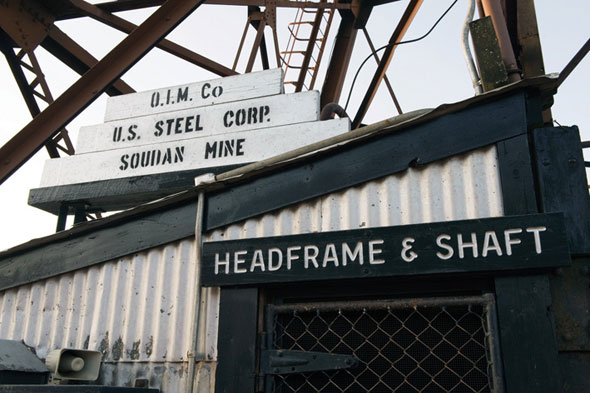 |
Making a place for physics in the deep
By Kathryn Grim
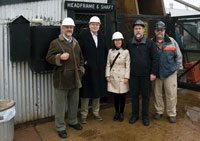 |
| From left: Pier Oddone, Fermilab director; Dennis Kovar, Department of Energy associate director of science for high-energy physics; and Young-Kee Kim, Fermilab deputy director, visited the Soudan Underground Laboratory in April 2009. Dan Bauer, Fermilab scientist and Cryogenic Dark Matter Search project manager, and Bill Miller, manager of the Soudan laboratory, led the tour. |
Just before 7:30 on a bitter-cold morning in northern Minnesota, engineer Jim Beaty begins the last leg of his daily commute. He steps into a dark brown metal box with five coworkers. Someone slides the door closed. In pitch dark, with its engine thundering, the elevator shudders as it travels a half mile below ground.
The sun has yet to rise, and it will have set by the time Beaty returns from the depths at 5:30 p.m.
But when he steps out of the elevator into the Soudan Underground Laboratory, it makes no difference what conditions are like on the surface. Down here the air is kept at 71 degrees Fahrenheit and its as bright as a cloudy day in late fall, just like it was the day before and will be on the day to come.
The laboratory is built into Minnesotas first iron ore mine, which operated from 1882 until 1962. The rock walls provide high-energy physicists with a shelter, for better or worse, from the Minnesota elements. They also shield experiments from cosmic rays and other particles that shower the surface of the Earth. By blocking some of the distracting subatomic debris from the sky, physicists can better watch for particles that rarely interact with matter.
Beatys job, as he describes it, is to provide the scientists who come here with whatever they need.
"I have a degree in mechanical engineering," Beaty says. "That doesnt necessarily mean Im an engineer every day. I was sweeping floors this morning. We do whatever needs to be done."
He is on a crew of about eight people who keep the laboratory running. Many of them also helped to build it. Beaty, a former construction worker, has been working at Soudan for more than 20 years. "It started as a temporary, two-week job, and it kept going," he says.
His story is similar to those of many of the laboratorys employees, including lab manager Bill Miller. Miller took a temporary job in the mine 25 years ago during the downtime most construction workers face in cold climates. He has worked at Soudan ever since.
"Most of us have been here a long time," Miller says. "We were all in the construction business building houses and things like that. Now were just building different things than we used to. Theres no one else in the world that knows how to do the things we do, because were the ones that built everything down here."
When Miller first began, the cavern was incomplete, and his desk sat behind a 50-horsepower air compressor. "The only way you could talk on the telephone was to have headphones on so you could knock out the sounds," he says.
He later moved to a desk next to the 6000-ton steel detector for the Main Injector Neutrino Oscillation Search experiment, or MINOS, which studies a beam of particles called neutrinos that zip straight through the ground from their source at Fermi National Accelerator Laboratory in Batavia, Ill. Today he works in an office built against the rock, which is painted white to match the other walls. He sits beneath a bulletin board covered in ticket stubs from hundreds of concerts and music festivals and a map of North America tracking the road trips he and his wife have taken with their two dogs in a fiberglass camper. "We havent quite hit all the states yet, but weve hit most of them," Miller says.
Everything in the high-energy physics laboratory from Millers roadmap to the hulking MINOS detectorhad to come down in the same elevator, piece by piece. And all of the rock the crew removed to carve out a space for the lab had to take the same elevator up.
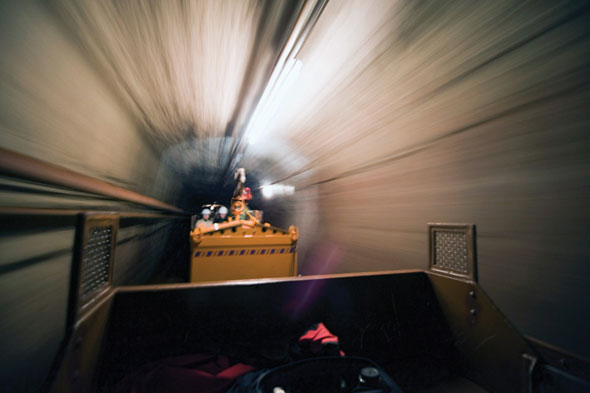 |
| Tours of the mine include a cart ride back to the last level where workers once collected iron ore. |
"We once actually had a list of how many trips we were taking," Beaty says. "It was a couple of thousand a year."
Recently Beaty has spent most of his time helping to upgrade the Cryogenic Dark Matter Search experiment. The CDMS experiment uses germanium and silicon detectors cooled to nearly the lowest possible temperature, minus 273 degrees Celsius, to listen for signals of dark matter particles. It sits in an area carefully guarded from most environmental contaminants. "Im servicing the cryogen tanks and the cryogen system, repairing anything that needs to be repaired, fixing, building whatever they want," Beaty says. "Weve got a machine shop here. If they want something, they sketch it out."
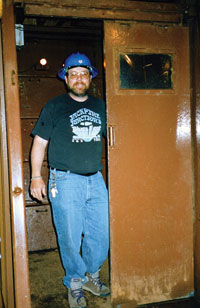 |
| Bill Miller circa 1992. |
He pulls from his desk what appears to be a dehydrated wet wipe onto which someone has scrawled an engineering design. "They cant bring paper and pens in there," he says. "Its a clean room."
When Beaty works in the clean room, he covers himself from head to toe in a "bunny suit," a white coverall made of anti-static material. Scientists slip plastic covers over their shoes, latex gloves over their hands and surgical masks over their faces to keep oil from their skin or hair from touching the CDMS detector. Contaminants on the detector can attract radon, a natural form of radiation emanating from the rock walls of the cave, and muddy the data collected.
Today Beaty is wearing a flannel shirt, jeans, and boots. He walks through a section of the cavern toward his office. In places the ceiling stretches 40 feet above his head. A small brown bat emerges from the shadows and flies straight toward him at waist height, only to cut a 90-degree turn at the last moment and zip back into the dark. Most of the caverns estimated 20,000-40,000 Little Brown Myotis bats live in an area 1000 feet up the elevator shaft.
"If you see a bat flying around down here, chances are its on its last legs," Beaty says. "Theres no food down here. Theres very little water."
A graduate student once proposed bringing mosquitoes into the mine to save the few starving critters who find their way to the bottom. Understandably, the rest of the researchers said no. Another student tried to catch and release the lost bats, but that presented too much of a safety hazard. None of the laboratory employees has been bitten, as far as Beaty can remember.
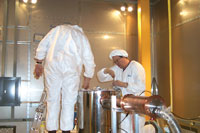 |
| Jim Beaty, right, in the underground clean room in 2001. |
Beaty climbs a set of metal stairs and steps into his 20- by 30-foot office, lit by daylight-mimicking full-spectrum light bulbs but otherwise just the same as any other workplace. He has a desk, a phone, a printer, and shelves full of manuals. "Two of us hauled almost this entire room down, and we helped erect it," he says.
Just outside of Beatys office sits one of the stranger items to make its way down the Soudan elevator: a ping-pong table. "A graduate student and I set this up one night when we were having to be here late," Beaty says. "We were waiting for a fridge to cool for one of the experiments. We found the old net, set it up, and we had a great time."
Beaty says he remembers the days when laboratory employees had a scorecard and kept track of the reigning ping-pong champion. But many of the experiments in the Soudan Underground Laboratory are coming to a close in the next few years, and fewer people spend their days in the mine. "Now its kind of hard to get a game," he says.
Eventually, Beaty, Miller, and the rest of the crew will dismantle the laboratory they built and bring it to the surface, one dark elevator ride at a time.
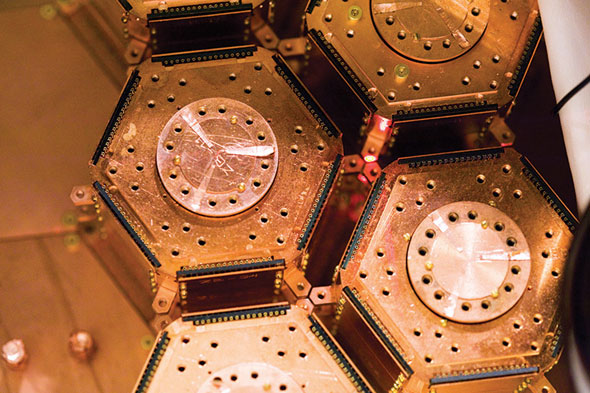 |
| Crystalline detectors of the Cryogenic Dark Matter Search. |
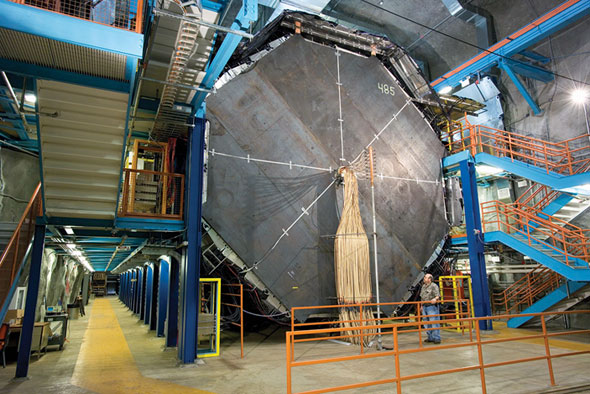 |
| The MINOS neutrino detector. |
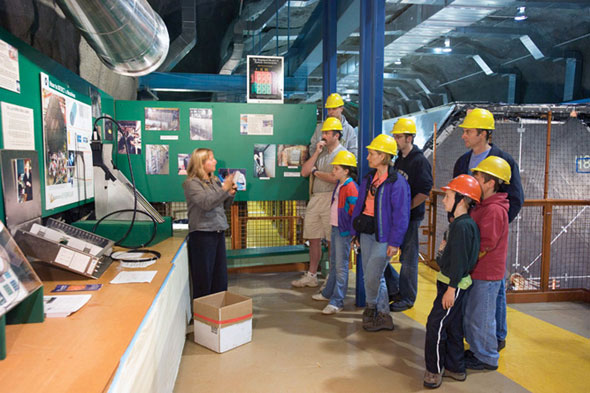 |
| A group of students tours the underground laboratory. |
 |
| Representatives of the Department of Energy, Fermilab and the University of Minnesota meet at Soudan to discuss research underground. |
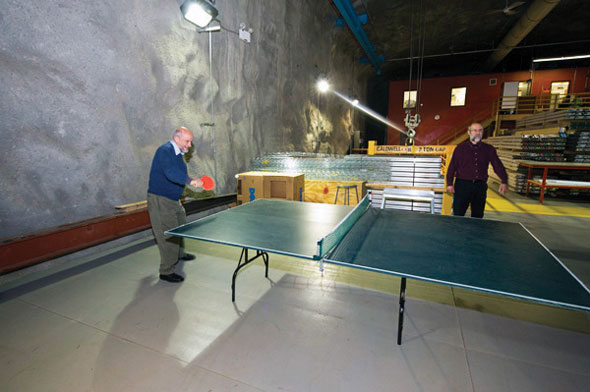 |
| Pier Oddone, left, tries out the underground pingpong table. |
Click here to download the pdf version of this article.






